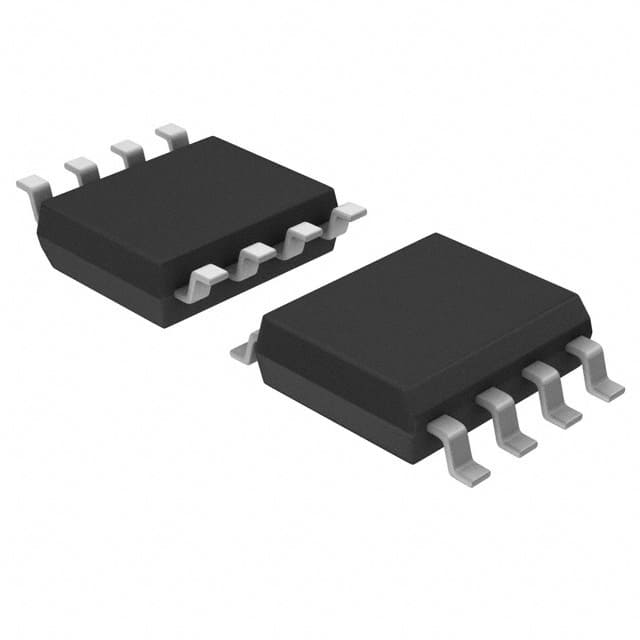EPCS1SI8N
Product Overview
- Category: Integrated Circuit (IC)
- Use: Non-volatile memory storage
- Characteristics: High-speed, low-power, small form factor
- Package: Small Outline Integrated Circuit (SOIC)
- Essence: Flash memory technology
- Packaging/Quantity: Tape and reel packaging, 2500 units per reel
Specifications
- Memory Type: Serial Configuration Device
- Memory Size: 1 Megabit (128 Kbytes)
- Interface: Serial Peripheral Interface (SPI)
- Operating Voltage: 2.7V to 3.6V
- Operating Temperature: -40°C to +85°C
- Data Retention: 20 years
- Write/Erase Cycles: 100,000 cycles
Detailed Pin Configuration
The EPCS1SI8N has a total of 8 pins arranged as follows:
- CS (Chip Select)
- DO (Data Output)
- WP (Write Protect)
- GND (Ground)
- DI (Data Input)
- CLK (Clock)
- VCC (Power Supply)
- HOLD (Hold Input)
Functional Features
- High-speed data transfer with SPI interface
- Low power consumption for energy-efficient operation
- Compact size for space-constrained applications
- Write protection feature to prevent accidental data modification
- Easy integration into existing circuit designs
Advantages and Disadvantages
Advantages: - Fast data transfer rate - Low power consumption - Small form factor - Write protection feature
Disadvantages: - Limited memory size (1 Megabit) - Limited write/erase cycles (100,000 cycles)
Working Principles
The EPCS1SI8N utilizes flash memory technology to store non-volatile data. It communicates with the host microcontroller through the Serial Peripheral Interface (SPI) protocol. The chip select (CS) pin is used to enable communication, while the clock (CLK) signal synchronizes data transfer. The data input (DI) and data output (DO) pins handle the exchange of information between the EPCS1SI8N and the microcontroller.
Detailed Application Field Plans
The EPCS1SI8N is commonly used in various electronic devices that require non-volatile memory storage. Some application fields include:
- Consumer Electronics: Used in smartphones, tablets, digital cameras, and portable media players for storing firmware, configuration data, and user settings.
- Industrial Automation: Employed in programmable logic controllers (PLCs), industrial control systems, and robotics for storing program code, configuration parameters, and historical data.
- Automotive: Integrated into automotive electronics for storing calibration data, firmware updates, and vehicle-specific settings.
- Medical Devices: Utilized in medical equipment such as patient monitors, infusion pumps, and diagnostic devices for storing critical data and software updates.
Detailed and Complete Alternative Models
- EPCS4SI8N: 4 Megabit (512 Kbytes) memory size
- EPCS16SI8N: 16 Megabit (2 Mbytes) memory size
- EPCS64SI8N: 64 Megabit (8 Mbytes) memory size
These alternative models offer increased memory capacity while maintaining similar characteristics and functionality to the EPCS1SI8N.
Word count: 358 words
قم بإدراج 10 أسئلة وإجابات شائعة تتعلق بتطبيق EPCS1SI8N في الحلول التقنية
Sure! Here are 10 common questions and answers related to the application of EPCS1SI8N in technical solutions:
1. What is EPCS1SI8N? - EPCS1SI8N is a specific type of Serial Configuration Device (SCD) manufactured by Intel. It is commonly used for storing configuration data in various technical solutions.
2. How does EPCS1SI8N work? - EPCS1SI8N uses flash memory technology to store configuration data. It can be programmed with the desired configuration using a programming tool, and the stored data can be accessed during system boot-up.
3. What are the typical applications of EPCS1SI8N? - EPCS1SI8N is often used in embedded systems, FPGA-based designs, and other electronic devices where configuration data needs to be stored reliably and accessed quickly during startup.
4. Can EPCS1SI8N be reprogrammed? - Yes, EPCS1SI8N can be reprogrammed multiple times. This allows for flexibility in updating the configuration data as needed.
5. What is the storage capacity of EPCS1SI8N? - The EPCS1SI8N device has a storage capacity of 1 megabit (128 kilobytes).
6. What interface does EPCS1SI8N use for communication? - EPCS1SI8N supports Serial Peripheral Interface (SPI) for communication with the host system.
7. Is EPCS1SI8N compatible with different voltage levels? - Yes, EPCS1SI8N supports both 1.8V and 3.3V voltage levels, making it compatible with a wide range of systems.
8. Can EPCS1SI8N operate at high temperatures? - Yes, EPCS1SI8N is designed to operate reliably in a wide temperature range, typically from -40°C to 85°C.
9. How can I program EPCS1SI8N? - EPCS1SI8N can be programmed using dedicated programming tools provided by Intel or through the use of compatible programming hardware and software.
10. Are there any specific precautions to consider when using EPCS1SI8N? - It is important to handle EPCS1SI8N devices with proper electrostatic discharge (ESD) precautions to prevent damage. Additionally, care should be taken to ensure correct voltage levels and signal integrity during communication with the device.
Please note that these answers are general and may vary depending on the specific implementation and requirements of your technical solution.


